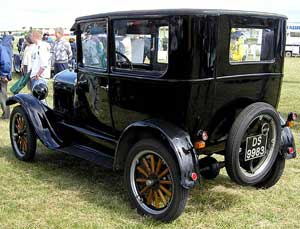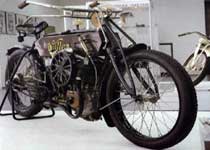Staying Safe on the Road Design and Early Safety Issues
While governmental authorities worried about controlling traffic, especially speed, car designers focused on making their vehicles go faster. Steam engines powered the first motorized cars. There was also some experimentation with electric cars. Designers soon turned to the more powerful gasoline-powered internal combustion engine, which eventually became the preferred propulsion system.
|
The Ford Model T made the automobile accessible to the masses. Collectors have restored many of these early autos. The 1925 Tudor Sedan was a highlight of an automobile show in Kemble, Gloucestershire, England. |
|
At the beginning of the 20th century, such cars began to be mass-produced in France and the United States. With engineering improvements, gasoline-powered engines soon allowed cars to achieve considerable speed. Henry Ford’s Model T, introduced in 1908 as "a car for the great multitude," was capable of going 56-64 km/h (35-40 mph). A 1913 model of the Rolls-Royce Silver Ghost, which was most emphatically not a car for the masses, reached a speed of 129 km/h (80 mph). At this time most cars had no hard top, and some were still open on the sides. Thus, there must have been many drivers and passengers who suffered the fate of Mary Ward.
The introduction of closed-body cars—with side doors and roofs—counts as one of the first safety improvements in automobile design. Closed-body design took hold on a large scale after World War I. During this time, steel replaced wood as the main building material for most cars; aluminum was also used in the more expensive cars. In the 1940s, Swedish car manufacturers Volvo and Saab started producing automobiles with safety cages, steel beams that help prevent cars from crumpling if they roll over.
While a closed body helped prevent people from being thrown out of a car in a collision, drivers and passengers continued to face danger from being thrown around the interior of a car. In the early days of the automobile, dashboards were made of rigid metal. Windshields, while no longer made from plate glass as they had been originally, could still shatter easily. In the event of a collision the steering column could impale the driver. Projecting knobs, handles, and levers were also a cause of injuries.
Beginning in the 1920s some American physicians began to urge the adoption of padded dashboards in cars, and, more important, seat belts, which were already being used in aircraft. It was not until the 1950s, however, that car manufacturers began to incorporate such recommendations into their vehicles. Again, Volvo and Saab led the way by adding padded dashboards and seat belts to their automobiles. Other manufacturers soon followed suit.
Motorcycles
|
The Walters Engine Factory in Germany began as a manufacturer of motorcycles in 1911. |
Couriers on motorcycles move small packages and documents in Buenos Aires, Argentina. Balancing packages can be tricky. |
Motorcycles first became popular in the 1880s. In the years after World War I, they entered the roads in large numbers. By their very nature motorcycles never acquired the protection of a closed body, of course. Motorcyclists thus remain much more vulnerable. There are safety regulations for motorcycles that parallel those for automobiles. These standards have evolved over the years as the technology for improved safety has developed.
This content has been re-published with permission from SEED. Copyright © 2024 Schlumberger Excellence in Education Development (SEED), Inc.




